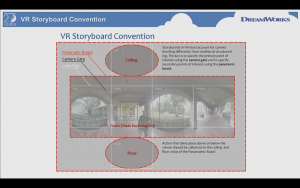Learning to Plan (Rosa Independent Learning)
by jarosajr
- May 12
- in
Moving from photography to video production this year forced me to add to my workflow. Capturing one single moment in a photographic frame is easy to do on the fly. Videography requires planning. Last semester I added pre-production planning and story boarding to my workflow to help me make better videos. When I moved to 360 degree videos, my workflow needed to adapt again. A standard storyboard is useless for 360 degree video. I cannot put a subject in a part of a frame. I cannot move the camera. I cannot zoom. I can't even have anything move in or out of the frame. As a videographer and storyteller my planning needed a major change. A video from the 2015 Silicon Valley Virtual Reality expo set me on my path to improvement.
Among other things, Brad Herman (Dreamworks Animation) talked about how his team adapted their preproduction workflow. They had to change their entire concept for storyboarding. Since there is no traditional frame in 360 degree video, the boards need to be concerned with much more than traditional boards. Dreamworks uses boards shaped like the layout of traditional catholic cathedrals. They have a large rectangle that encompasses the entire 360 degree view of the cameras, with two circles on the top and bottom of the left hand side of the rectangle that are used for designing the roof and floor of every shot. This basic layout serves as the starting place for designing scenes.
Writers needed to adapt more than just their tools, however. The Dreamworks team and all 360 storytellers must be concerned with the dynamics of 360 video as well. Herman divides 360 space into three sections:
- Personal Space — The area closest to the person/camera. This area directly influences the viewer and can be an interactive space.
- Action Space — This is the area just outside of the viewer's personal area. It is not interactive, but it is the main location Dreamworks sets their narratives.
- Vista Space — The area farthest away from the viewer. The narrative doesn't reach this far out. It is too distant from the viewer to be actively watched. Instead, Dreamworks uses this area for background information and scene setting like time of day and location clues.
Once you understand how to tell a story using the technology, and have the tools to plan your story, any videographer needs to deeply understand the physical space they will be shooting in. Herman and the Dreamworks team utilize a 360 camera for this role. Where a traditional videographer might use a photo camera to snap scouting shots of locations, Herman and his team use a Ricoh Theta camera. They pair the camera with a Gear VR to be able to view scouting shots 10 seconds after they're taken and allow themselves plenty of on-site flexibility. I do not have a Gear VR, but when I used the Ricoh Theta S to scout locations for my shoots, I would simply use the Ricoh camera's mobile app on my phone to achieve the same goal. Unfortunately, my method takes a bit longer than the Gear VR, but it works well enough for me. These scouting shots can help writers and directors figure out what height cameras should be at, how to plan a shoot and manage the people on set, and for Dreamworks, the shots are useful as references for animators.
Pre-productions is a vital part of any form of videography. The nature of 360 degree videos poses an interesting dilemma for the emerging industry, but teams like Dreamworks have come up with inventive and effective solutions to the problem. These new tools and techniques allow films to be effectively planned and executed efficiently during production. After some iterations and trials shooting 360 degree video, I began effectively implementing the tricks I'd learned from Dreamworks. The simple pre-production steps helped me hugely. It ended up making my production process efficient enough for me to plan, shoot, and edit my final VR 360 degree video project in a single afternoon (with some help from the Ricoh Theta S of course).

COMMENTS